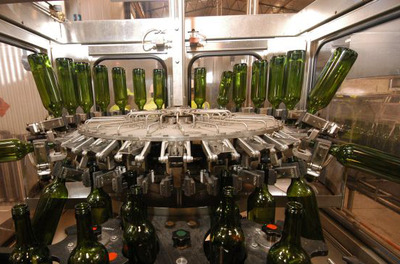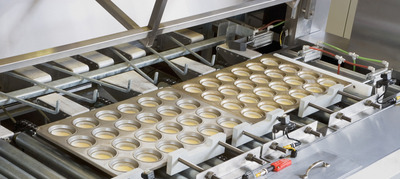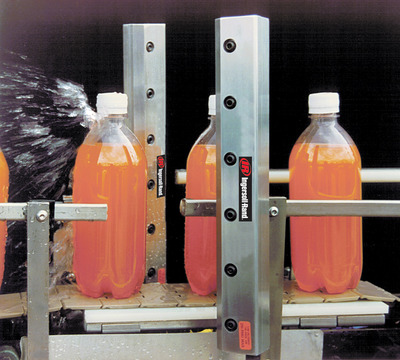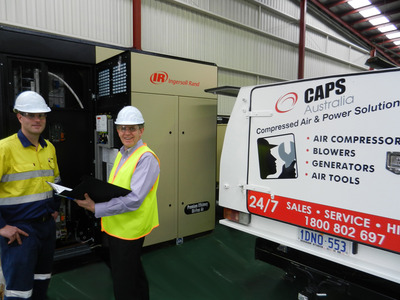Class 0 compressed air for the food processing and pharmaceutical industries
The cleanliness and quality of compressed air used is vital to prevent contamination of the end product in food and pharmaceutical manufacturing, and to provide safe operation of specialised equipment in hazardous environments. Dino Alessio, compressor engineer and National Sales Manager at CAPS Australia, reviews the international standard for compressed air quality and the technology to provide Class 0 air.
Compressed air is an important and major part of most manufacturing and industrial processes. Knowing the proper air quality level required for effective and efficient operation of equipment or a manufacturing process is an important factor in containing compressed air energy and other operating costs. Higher-quality air is more expensive to produce and requires additional air treatment equipment, which increases capital costs as well as energy consumption and maintenance needs. The degree of dryness and filtration of compressed air required for a process, and the minimum acceptable contaminant level of any finished product, should determine the quality of air required.

One of the main factors in determining air quality is whether oil-free air is required. If only a single process requires this type of air, it may be supplied by a dedicated oil-free compressor or by the necessary filtration equipment at the point of use. If the end uses in a plant require different levels of air quality, it may be advisable to divide the plant into different sections so that air treatment equipment that produces higher-quality air is dedicated to the end uses that require the higher level of compressed air purification.
Using clean and pure compressed air
For the taste of it
Food and beverage manufacturers use compressed air to push foodstuffs, such as powders and cereals, through pipes and they often has direct contact with the product during processing. It may also be used to cool down baked goods, clean bottles or spray produce. In some applications, compressed air supplies oxygen to bacteria for fermentation or is pumped into liquids to raise dissolved oxygen levels. The cleanliness and quality of compressed air used in food and beverage processing is therefore vital to prevent contamination of the end product and potential harm to the health of consumers.

Food product recalls and food safety concerns are increasingly influencing consumer shopping behaviour. A recent study found that such concerns prompted 38% of consumers surveyed to stop purchasing certain foods. Compressed air is often identified as a potential source of contamination. While the majority of consumers acknowledge that they have some level of responsibility for ensuring the products they consume are safe, a growing number of consumers ultimately hold the manufacturers accountable.
Improved product purity
Compressed air is used in a variety of manufacturing processes in the pharmaceutical industry. It is frequently used to de-dust tablets or spray on pill coatings. Compressed air is used to maintain over-pressurisation in mixing and holding tanks to ensure product integrity. It may also have direct contact with the product or packaging during dosing and filling, or when the application demands aseptic air. Pharmaceutical industry regulations state that “each manufacturer shall establish and maintain procedures to prevent contamination of equipment or product by substances that could reasonably be expected to have an adverse effect on product quality”.

In order to prevent contamination of the end product and possible harm to patients, the cleanliness and quality of the compressed air supply is vital to eliminating the risk of rejections and/or health risks associated with oil contamination.
Safe operation in hazardous areas
Oil and gas production and handling can be dangerous processes in which health and safety are paramount. Compressed air is non-flammable so it can be used in hazardous environments and be used in a multitude of applications in these industries. Whether used for breathing air or operating manufacturing equipment used in many processes, compressed air is the first choice for safety.
Compressed air is used in a vortex tube for cooling processes and to drive air-operated pumps as an alternative to electrically driven pumps which could spark and cause an explosion. Compressed air is also used in a variety of cleaning processes such as reverse air jet purging of filters or as the propellant for the cleaning ‘pig’ when clearing the inside of pipelines. Portable compressed air systems can be used for the internal de-scaling of mobile oil and gas tanks or as a stand-by backup for a site’s stationary compressors.
Sources of contamination
The three primary contaminants of a compressed air system are airborne particulates, water and oil. It is possible for a single drop of unwanted oil to cause an entire automated process to malfunction by causing seals to swell which may result in complete seizure of moving parts. Other contaminants that may impact production processes include solid particles such as dust and rust, condensed water droplets from ambient humidity, and liquid oil and oil vapours.
Solid contaminants can wear out compressor machinery, cause motors to jam, and block valves and vent orifices. Airborne particulates will cause pneumatic equipment to malfunction, failure of instruments and control systems, and contamination of end products. These events increase the cost of running the compressors by increasing the maintenance required to clean and repair components.
Water, both liquid and vapour, will oxidise pipework and pneumatic equipment, ruin paint finishes and can potentially make the products being manufactured unable to be sold. Oil-based vapour and liquid can have similar effects on machinery and end products.
In addition to the cost of increased maintenance and loss of manufactured product, sudden equipment stoppages are expensive in terms of loss of product and time to repair and restart a production line.
Setting the standard
The International Organization for Standardization (ISO) developed the compressed air quality standard - ISO 8573 - in 1992. The standard was designed to provide plant engineers and equipment suppliers with an internationally known and accepted unit of measure. The standard defines a series of ‘Quality Classes’ relating to the concentration of solid particulates, water vapour and oil in output of an air compressor.
For example, ISO 8573-1:2010 Class 1.2.1 specifies a particular air quality. The last three digits in the designation - in this case 1.2.1 - relate to the purity classifications selected for solid particulates (1), water (2) and total oil contamination (1).The designation begins with the name of the standard document and its revision number.
Class 1 for solids means that in each cubic metre of compressed air, not more than 20,000 particles in the 0.1 to 0.5 micron size range, 400 particles in the 0.5 to 1 micron size range and 10 particles in the 1 to 5 micron size range are permitted. The 2 classification for water indicates that there must be a pressure dewpoint (PDP) of -40°C or better and that no liquid water is allowed in the output air. The third digit, 1 in the example, indicates that the total level for liquid oil, oil aerosol and oil vapour must not exceed more than 0.01 mg of oil in each cubic metre of compressed air.
Class 0 is the most stringent air quality classification, strictly limiting oil contamination in liquid, aerosol and vapour forms. This classification requires agreed and measurable contamination levels that are included as part of a written specification for a compressor. Air for critical applications such as breathing or medical and food production may still require additional purification equipment in both the compressor room and at the point of use depending on the nature of the air being drawn into the compressor.
Oil-free compression
Rotary screw compressors use two meshed rotating helical screws to force the gas into a smaller volume and are usually used for continuous operation in commercial and industrial applications. This type of compressor can have engine sizes from 2.2 kW to more than 890 kW and from low pressure to moderately high pressure more than 8.3 MPa. The gas compression process of a rotary screw is a continuous sweeping motion, which minimises pulsation or surging of the discharge flow.

In an oil-free version, the air is compressed entirely through the action of the rotary screws, without the assistance of an oil seal. These units often have lower maximum discharge pressure, but multistage oil-free compressors - where the air is compressed by several sets of screws - can achieve greater pressures and output volumes of more than 50 m3 per minute.
Oil-free compressors are used in applications where oil contamination is not acceptable, such as medical research and semiconductor manufacturing. Some form of additional filtration is often required as contaminants can be drawn in from the ambient air and must be removed prior to where the compressed air is used.
Oil-free rotary screw and reciprocating compressors usually have higher initial costs, lower efficiency and higher maintenance costs than their lubricated counterparts. However, the additional separation, filtration and drying equipment required by oil-injected compressors will generally cause some reduction in system efficiency, particularly if the system is not properly maintained.
By providing pure air, free from additional contaminants, these compressors minimise downtime associated with cleaning filters and other air system components. Oil-free technology increases productivity and ensures higher overall product quality.
All Ingersoll Rand compressors that are designated oil-free and supplied by CAPS Australia - the largest Australian-owned independent compressed air company - have been certified as meeting the Class 0 air quality standards. This certification was achieved following rigorous testing by TÜV Rheinland - a global leader in independent testing and assessment. Certified Class 0 compressors deliver consistently clean, sterile air to critical applications.
Ingersoll Rand oil-free rotary screw and centrifugal air compressors also help manufacturers comply with environmental standards such as ISO 14001 and European Union regulations. Because the compressors are oil-free, manufacturers do not encounter disposal issues with waste oil and filtration components. Disposal of air compressor condensate can also be an issue in traditional, lubricated compressors. By creating a clean condensate that is easier to dispose of, oil-free compressors do not require special treatment for oil and water mixtures.
Summary
Class 0 compressed air ensures higher product purity and process integrity, minimising the risk of oil contamination being transferred directly to a product being manufactured or interfering with the operation of equipment.
By selecting certified oil-free compressors, food and beverage manufacturers, pharmaceutical companies and process operators can enjoy the peace of mind that comes with knowing their critical air supply is completely free of compressor-created contaminants.
Kokumi chemistry for rich-tasting sparkling wines
Kokumi compounds can bring a richness of flavour to foods like cheese, but now scientists have...
From cream to clean: ice cream maker implements organic wastewater solution
An ice cream manufacturer transitioned from traditional aluminium-based coagulants to a...
Maximising yield and minimising waste in dairy processing
Rockwell Automation Model Predictive Control technology is designed to optimise dairy processes...










